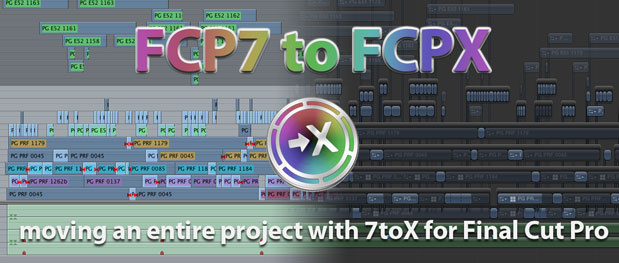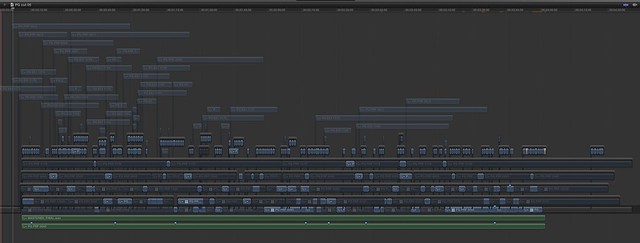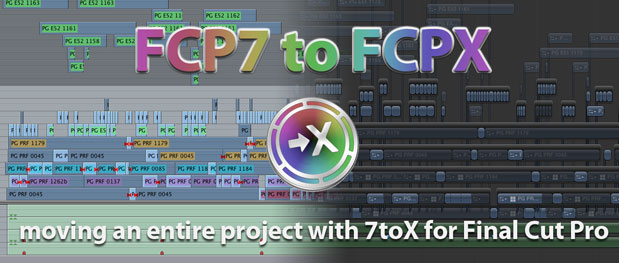
When Apple released the latest Final Cut Pro X update there was a very important 3rd party utility released right alongside the 10.0.3 update that finally allowed the importing of legacy FCP7 projects into FCPX. It wasn't entirely surprising that it was Intelligent Assistance releasing 7toX for Final Cut Pro. I say that because they had already created Xto7 (to move projects from FCPX to FCP7) and are arguably the best company for creating high-quality XML workflow tools for the FCP universe. There's been tons of blog posts about 7toX for Final Cut Pro since its introduction but most of them are nothing more than a here it is here's the link kind of thing, including one of my own. Many have taken a simple sequence to try this conversion but my thought was to throw everything at 7toX for Final Cut Pro and see how well it did … or didn't work.
Of course the most surprising thing is still that Apple didn't build this capability directly into FCPX from the beginning but it's better to get it late from a 3rd party rather than never get it at all.
We all know that Apple has said that it wouldn't really be possible for FCPX to import FCP7 projects due to the difference in the timeline, differences in media management and overall different philosophy in how the two applications work. This point was reiterated further upon the 10.0.3 release when Apple stated that “it was never going to be possible for us (Apple) to do perfect fidelity” in an FCP7 to FCPX conversion. That's probably true of anyone since the two applications differ so greatly. With that Apple passed this task to Intelligent Assistance. Better to let them feel the wrath of the angry user when the conversion doesn't go as planned I suppose.
Putting it to the test on a big project
I was very curious as to how well the conversion would work. One thing that's mentioned on the 7toX website is that the conversion isn't just for sequences. It works via XML out of FCP7 and XML into FCPX. One thing about XML from FCP7 is that it's dependent on what you have selected when you export. A single sequence selected will export just that. Nothing selected will export the entire project.
I was curious as to how well it would work converting an entire project. The project I chose to throw at it was a music video that was cut from a live performance, a bit of music video specific performance and a ton of broll. It was a large job considering there was well over 10 hours of media. The performance itself was captured with 7 cameras and that includes rehearsals as well as the live performance. There were the odd GoPro placed around the stage. Add to that a few takes of the artist performing parts of the song to a track in a more abstract setting (I don't have permission to show any of the footage or images) and that's over 25 angles.
To complicate things even more, during the live performance that was captured the band wasn't exactly playing the same version of the song from the master audio that we had to cut to. That means the sync didn't hold. All things considered when I got done with my cut I had one messy timeline.
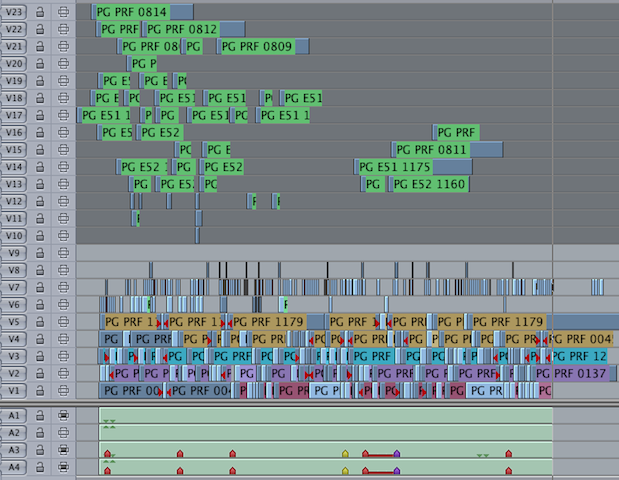
While it looks like quite the mess this timeline is actually quite organized!
Normally I wouldn't let a timeline that sloppy see the light of day but in this case it was a necessity. Some angles were able to be grouped into an FCP7 multiclip. Several multiclips had to be made; some for the live performance, some for the rehearsal. The abstract performance was stacked above everything else. I made a sync map of all the angles I could before I began to see what I had. I actually made a number of sync maps for different things, labeled them with a color and sent them to PluralEyes for syncing. After I got a performance cut I liked I then layered in broll as the edit went along. When I was done was the timeline above is what I gave it to the director to view and make any tweaks that he thought was necessary.
The export from Final Cut Pro 7
As for how the media in the FCP7 project was structured:
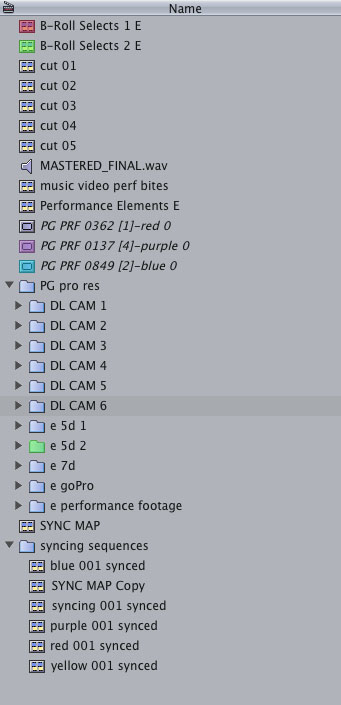
I didn't want to take up the screen real estate to twirl down all the footage bins.
This was to be quite the test for 7toX. To get my XML I deselected everything in FCP7 and exported the XML.
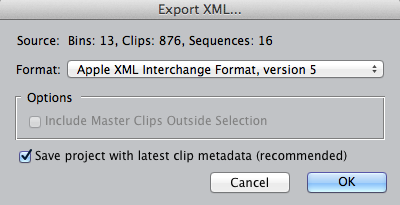
While the edits were only around 4 minutes there was over 10 hours of media.
I then ran that XML through 7toX for Final Cut Pro. It took 7toX 15 minutes to process the 17MB XML.
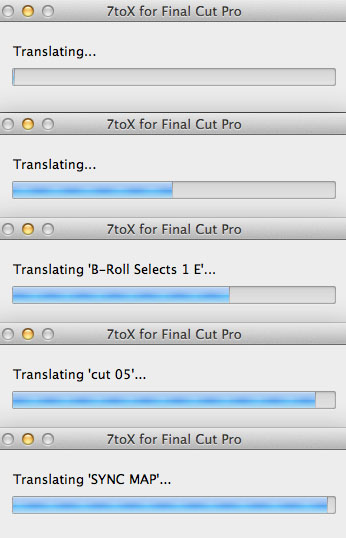
As 7toX was progressing it will often show what exactly it is translating. This is a nice touch when you've got a big job like this one.
I often wondered if it had crashed but I didn't force quit, I let it soldier on. Finally, a 2.6 MB FCPX XML came out the other side.
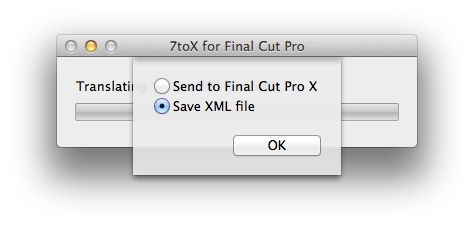
Once 7toX is done it asks what to do.
The import into Final Cut Pro X
I took that new .fcpxml and imported it into FCPX. That import process took about 13 minutes and I really did wonder of FCPX had crashed as the beach ball started spinning after a few minutes.
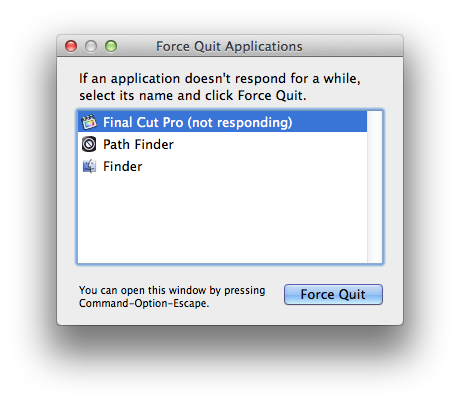
This is usually a bad sign.
I think normally I would have force quit … in fact I did but when I went back into FCPX it has processed through and imported some of the events. The second time I kept an eye on the media drive (as well as the cpu) and occasionally saw it flashing so I knew FCPX was doing something. Even with the Force Quit window saying FCPX was not responding after 13 minutes it had finished. Then I had a new Event in FCPX with a lot of events and a lot of media.
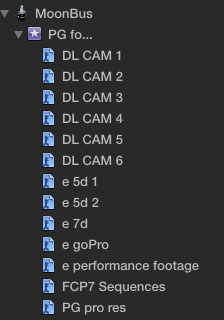
That's pretty similar to the FCP7 project above.
As I looked around in FCPX I found all my master clips, quite a few Compound Clips that represented my sequences from FCP7 (in an event called FCP7 Sequences) as well as new to 10.0.3 Multicamera Clips. I then opened up my final timeline by editing the Compound Clip into a timeline and choosing Break Apart Clip Items.
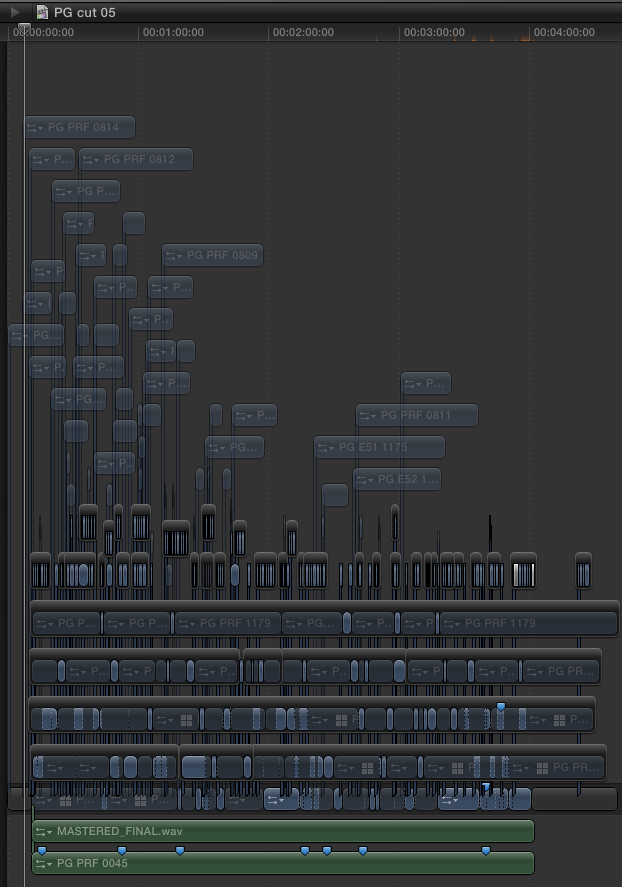
That's a pretty nice conversion of a complex timeline for something that we were told probably wasn't possible.
I have to admit I was stunned that it came across so well. Almost everything is there in this rather insane timeline. Multicamera clips, the master audio, both enabled and disabled clips. It wasn't 100% as there were some clips that were out of sync but for the most part it worked. And that was a lot of DSLR media and we all know DSLR media isn't the best when it comes to timecode. Was the “fidelity” 100%? Nope but it's a conversion that Intelligent Assistance should be proud of because this wasn't an easy project to convert.
The biggest overall problem that I saw in this conversion came from the scratch audio on all the cameras. This wasn't a problem of 7toX but rather in the way FCPX works. It wouldn't be a problem in some edits but in this type of project it would cause some extra work. All the clips imported into the FCPX timeline with camera audio intact while that camera audio had been removed from the FCP7 sequence. This is one of those fundamental differences between the applications and points to FCPX's weakness in handling audio overall. When I would play the cuts in FCPX I would hear my master audio and depending on the cameras chosen their scratch audio would come blaring out, sometimes more clips than one.
There's no easy way to disable all the audio at once and when I would select the Multicamera clips in the timeline to disable the audio in the Inspector it said this:
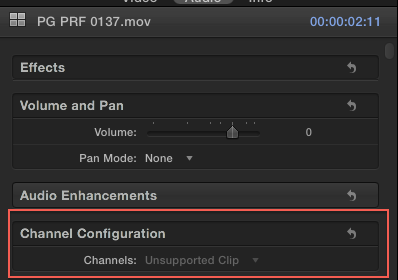
It didn't work to uncheck the audio for the Multicamera clips in the Inspector but the Volume did.
What I was able to do is select more than one clip at a time in the FCPX timeline and just turn the Volume down all the way. It worked but it was tedious and it makes me think FCPX is having to process some unnecessary audio. If they can figure out a way to deal with this audio conversion from 7 to X then a translation of this type edit might be near flawless.
Up Next: Some thoughts on the conversion as well as some other timeline comparisons.
Some thoughts on the conversion
• All the clips are listed in the single Event that 7toX created and each FCP7 bin is now a Keyword Collection.
• A new Keyword Collection was created that contained all the FCP7 sequences. I had all my FCP7 bins nested in another bin and 7toX created a Keyword Collection for that too.
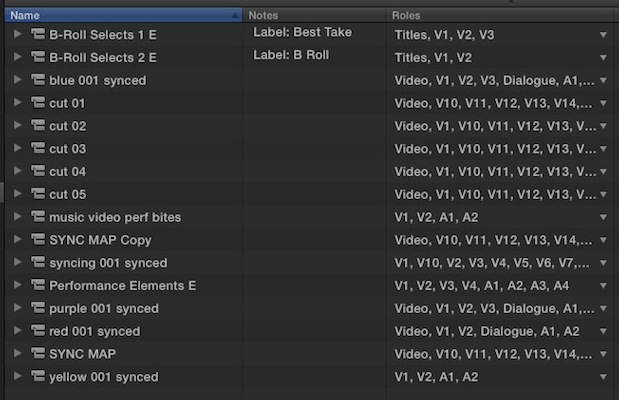
That's all the edits that I had in the FCP7 project.
• Clips or sequences that had an FCP7 color label got those labels noted in the FCPX Notes column:
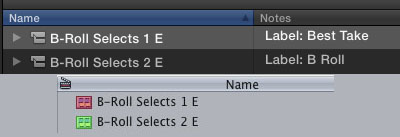
I hope that in the future FCPX will gain color labels of some sort as that's so helpful for organization.
• Each clip was assigned a Role corresponding to the video track in FCP7. I had 23 video tracks in FCP7 and 23 roles in FCPX. You can have each clip in the timeline label with its Role and that's an easy way to see exactly how things got laid out in FCPX.
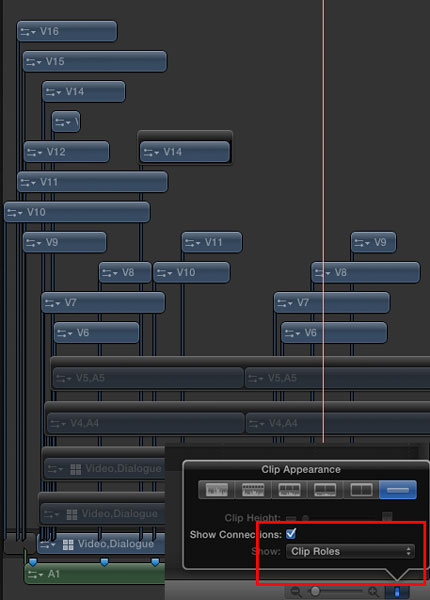
Since there aren't video tracks in FCPX 7toX assigns a Role to each clip based on the FCP7 video layer. That's a nice touch to help with organization in FCPX.
• 7toX created Secondary Storylines for something like 7 layers in the FCPX timeline. It feels like it could have used even more Secondary Storylines and replicated the FCP7 tracks even more faithfully. If you compare the two timelines you'll see tracks 10 – 23 were disabled in FCP7 and those are the ones that didn't get Secondary Storylines in FCPX. Maybe that has something to do with it.
• This project didn't have any filters, keyframing, transform or motion effects so that type of data translation wasn't tested.
• As mentioned above if 7toX could automatically turn off the audio for timeline clips that didn't have their audio edited into audio tracks it would be even more faithful. One option might be to detach the audio for those clips (if that's possible) and disable that audio
• FCPX was quite speedy on this large project. What it is still not speedy on is an older multicamera standup comedian show that I've been working on. That's a 3-camera 90 minute timeline as opposed to this 4 minute one.
• A zero should be added to the track / roles names (V01, V02 instead of V1, V2) so the Roles sort properly. That's just one of my pet peeves when an NLE can't sort properly.
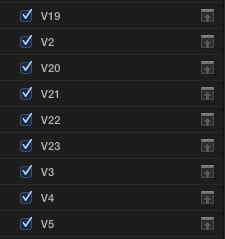
A zero in front of those single digits would make that a proper sort.
Some other timelines
Here's a few other timelines just to compare and contrast.
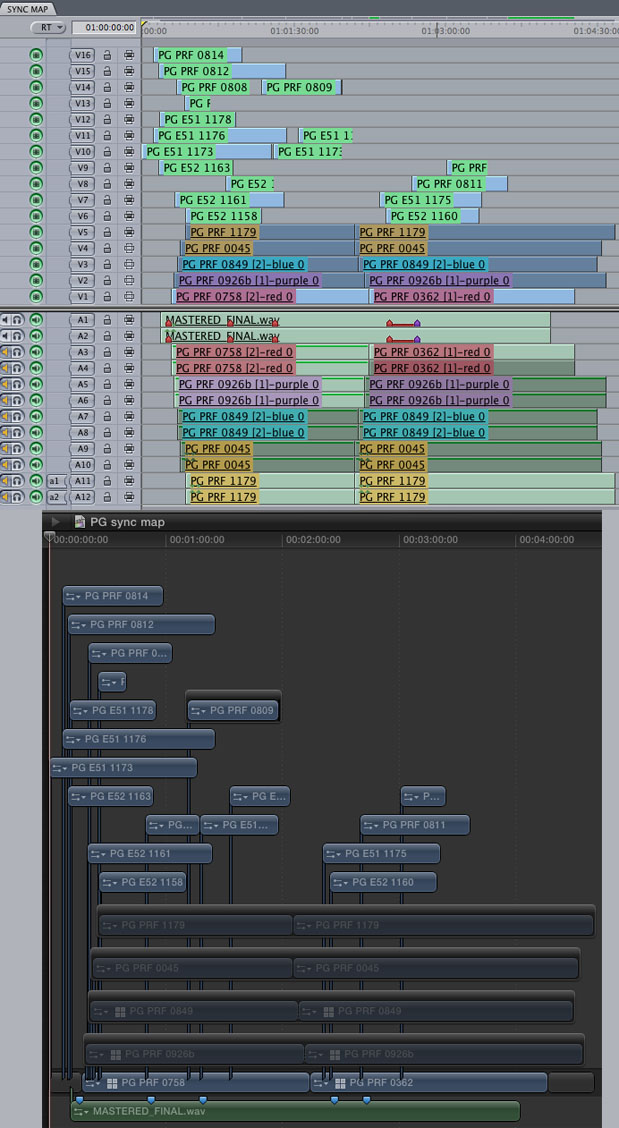
This was one of my first sync maps for the project.
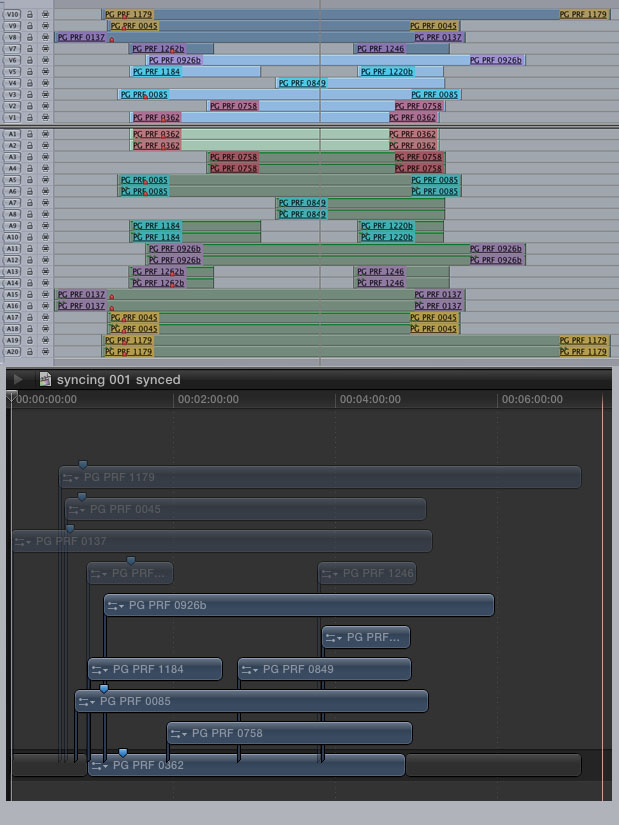
One of my PluralEyes sync sequences. Notice the Markers came across.
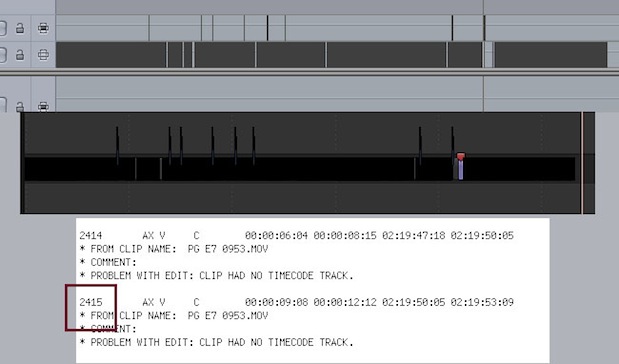
This was a 2415 event sequence of the director's selects. Yes that's a mess when zoomed out but all the events were there.
Here's the main cut in both FCP7 and FCPX embedded from FLickr below for closer comparison. Click the images below to go to Flickr for a larger image.
Wrap up
The guys at Intelligent Assistance should be proud of themselves as they've done what Apple couldn't / wouldn't do. As different as FCP7 and FCPX are I don't think anyone would expect perfect fidelity when moving between the applications unless Apple had designed some type of conversion in from the start. Yes they are different but they both have timelines that pretty much stack clips vertically, both have different camera angles grouped into one clip and both have places to store that original footage so they are similar enough that a good conversion is possible. I just hope Apple doesn't build this functionally into FCPX and make the third party utility 7toX for Final Cut Pro obsolete, as they tend to do. I'm sure the Intelligent Assistance guys put in a lot of hours on it so maybe they'll make some money back.
7toX for Final Cut Pro is available from the Mac App Store for the extremely reasonable $9.99. Thanks to Philip Hodgetts of Intelligent Assistance for sending over a copy of the app to test out. He's got several articles about the app on his blog. There's also a much deeper list of all that 7toX for Final Cut Pro can do and how exactly it does some of the conversions on the Intelligent Assistance website.

Filmtools
Filmmakers go-to destination for pre-production, production & post production equipment!
Shop Now